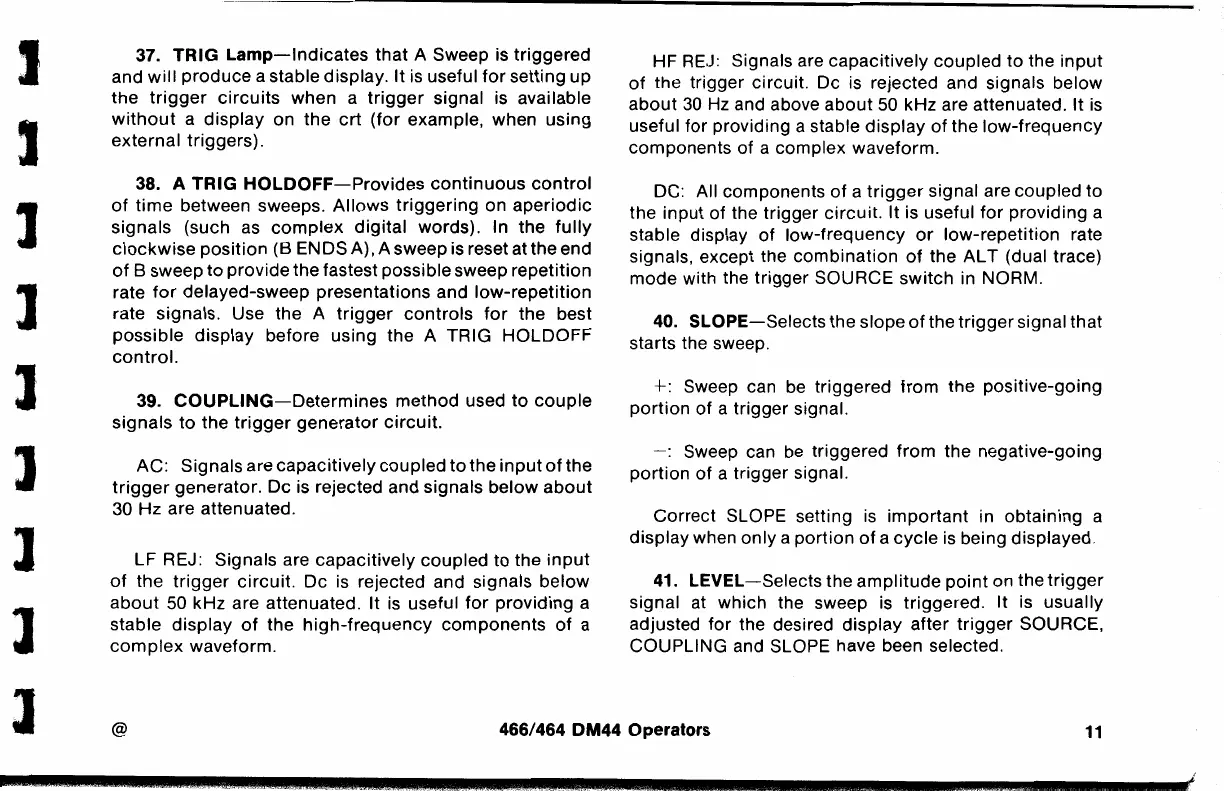J
J
]
l
J
J
l
l
37.
TRIG
Lamp-Indicates
that
A Sweep is
triggered
and
will
produce
a stable display. It is useful
for
setting up
the
trigger
circuits
when a
trigger
signal is available
without
a
display
on
the
crt
(for
example, when using
external triggers).
38. A
TRIG
HOLDOFF-Provides
continuous
control
of
time
between sweeps.
Allows
triggering
on
aperiodic
signals (such as
complex
digital
words). In the
fully
clockwise
position
(BENDS
A), A sweep is reset at the end
of
B sweep
to
provide the fastest possible sweep repetition
rate
for
delayed-sweep presentations and
low-repetition
rate signals. Use the A
trigger
controls
for
the best
possible
display
before using the A TRIG
HOLDOFF
control.
39.
COUPLING-Determines
method used
to
couple
signals
to
the
trigger
generator
circuit.
AC: Signals are capacitively
coupled
to
the
input
of
the
trigger
generator. De is rejected and signals
below
about
30 Hz are attenuated.
LF REJ: Signals are capacitively coupled
to
the
input
of
the
trigger
circuit.
De is rejected and signals
below
about
50 kHz are attenuated. It
is
useful
for
providing
a
stable
display
of
the
high-frequency
components
of
a
complex
waveform.
HF
REJ:
Signals are capacitively coupled
to
the
input
of
the trigger circuit. De is rejected and signals below
about
30
Hz and above
about
50 kHz are attenuated. It
is
useful for providing a stable
display
of
the
low-frequency
components of a complex waveform.
DC: All components
of
a
trigger
signal are coupled to
the input
of
the trigger
circuit.
It is useful
for
providing a
stable display
of
low-frequency
or
low-repetition rate
signals, except the
combination
of
the
ALT
(dual trace)
mode
with the trigger SOURCE
switch
in NORM.
40.
SLOPE-Selects
the slope
of
the
trigger
signal that
starts the sweep.
+:
Sweep can be triggered
from
the positive-going
portion
of
a trigger signal.
-:
Sweep can
be
triggered
from
the negative-going
portion
of
a trigger signal.
Correct SLOPE setting
is
important
in obtaining a
display when
only
a
portion
of
a
cycle
is being displayed.
41.
LEVEL-Selects
the
amplitude
point
on the
trigger
signal at which the sweep
is
triggered. It is usually
adjusted
for
the desired display after
trigger
SOURCE,
COUPLING and SLOPE have been selected.
@
466/464 DM44 Operators
11

